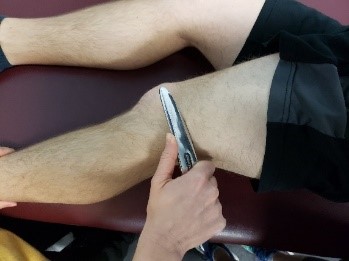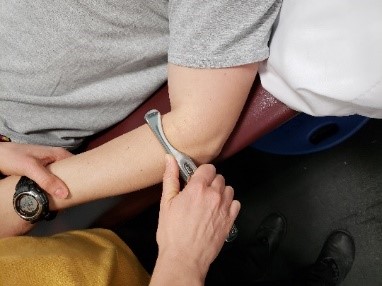Graston Technique
Laura L Jacobs, DPT
Fyzical Therapy and Balance Centers
Have you ever had a nagging ache, pain or tightness that just likes to hang around for too long and keeps you from enjoying life? Physical therapists use many different techniques and tools to help people return to normal pain free function. Land or aquatic exercises, manual techniques, modalities such as ultrasound, laser, and electrical stimulation can be part of a treatment plan. While many approaches are familiar to most people, not too many have heard of the Graston Technique. You may be wondering why tools that look like knives would be a good idea to treat pain or motion restrictions but this technique has been proven through research and in the clinical setting to be very effective. I have been using the Graston Technique in my practice for about 6 years now.  I was first introduced to the technique while I was a student and was fascinated by what it could do. I have used it to successfully to treat a widespread of conditions such as plantar fasciitis, Achilles tendinitis, tennis elbow and lower back pain to name a few. It improves range of motion while reducing pain, leading to a return to normal function. So what is it? Graston is a type of instrument assisted soft tissue mobilization. That is a mouthful, but basically what it means is I use instruments to perform soft tissue work instead of my hands. The Graston Technique utilizes stainless steel instruments to address fascial restrictions and soft tissue lesions, also known as stubborn injuries and can help break down and realign scar tissue. It has been shown to increase blood flow and trigger your body’s natural healing response. When normal, healthy tissue is damaged, the body often heals it in a haphazard manner, leading to restricted movement and pain. These are the areas where Graston Technique can be beneficial.
I was first introduced to the technique while I was a student and was fascinated by what it could do. I have used it to successfully to treat a widespread of conditions such as plantar fasciitis, Achilles tendinitis, tennis elbow and lower back pain to name a few. It improves range of motion while reducing pain, leading to a return to normal function. So what is it? Graston is a type of instrument assisted soft tissue mobilization. That is a mouthful, but basically what it means is I use instruments to perform soft tissue work instead of my hands. The Graston Technique utilizes stainless steel instruments to address fascial restrictions and soft tissue lesions, also known as stubborn injuries and can help break down and realign scar tissue. It has been shown to increase blood flow and trigger your body’s natural healing response. When normal, healthy tissue is damaged, the body often heals it in a haphazard manner, leading to restricted movement and pain. These are the areas where Graston Technique can be beneficial.

The instruments help keep my hands injury free while setting my patients on the path to healing. These instruments allow me to detect things I wouldn’t normally be able to feel with just my hands. I am able to feel the vibration and texture changes in the underlying tissue. It’s a great technique because the patient can be involved. During treatment, patients are able to feel a grittiness in injured areas and over multiple treatment sessions they are able to feel how it changes and smooths out. While undergoing treatment, you are allowed and encouraged to keep performing your normal activities as long as they are performed pain-free. There has been a lot of research performed on this technique that shows positive outcomes in majority of all conditions treated when performed correctly and with good compliance from the patient. Graston Technique sometimes gets a bad reputation for being painful and causing post-treatment bruising, but that is not the goal. Sometimes this occurs, but treatment can be adjusted to minimize this. If you have ever had a deep tissue or sports massage you might have been a little sore or tender the next day. Graston is the same way.
Where on the body can you use the Graston Technique? I get asked that question often and my answer is “Pretty much anywhere!” The most common areas it is used on are neck pain, shoulder pain, tennis elbow, carpal tunnel syndrome, lower back pain, hip pain, IT Band (iliotibial band), knee pain (such as runner’s knee or jumper’s knee), shin splints, ankle pain and foot pain. It can also be used on old scars resulting from a knee replacement or a C-section. It doesn’t matter how old or new the injury is, treatment can be adjusted to aid in your rehabilitation. One of the best features of this technique is that it can be used on all people of all ages, young or old, and all activity levels. Whether your goal is to run a marathon or play with your grandkids, there is a great chance this technique will get you back to living life the way you want to!
To make an appointment call 717-591-3000 or click here